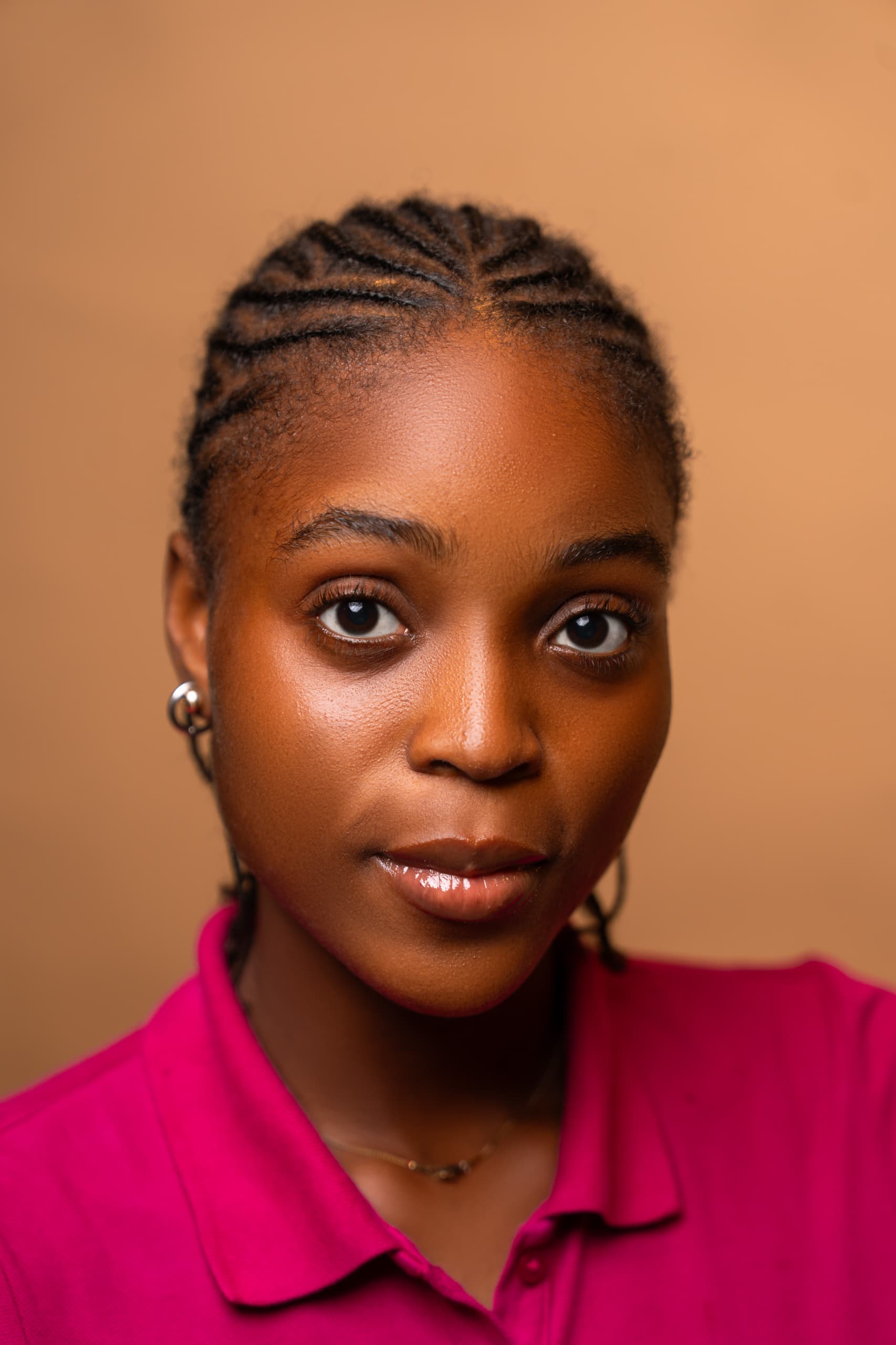About James Hannah :
Tell us about your artistic background and experience. What led you to pursue art as a creative outlet?:
I was born and raised in Lagos, Nigeria, where my earliest memories are filled with color, texture, and the shifting dance of light and shadow. My creative path took shape during my studies at the University of Lagos, Faculty of Arts, in the Department of Creative Arts, where I chose to specialize in painting. This academic journey deepened my technical skills and exposed me to the histories and theories that continue to inform my practice.
I also trained under Wallace Davies Ejoh at The Simple Plan Studios and the TSTTV Studio during my industrial attachment. These mentorships were pivotal, sharpening my eye for composition, brushwork, and the expressive possibilities of color. Over time, I developed a signature style rooted in chiaroscuro, using dramatic light and shadow to create volume and atmosphere paired with a discordant color palette, often centering blues and purples tempered by cool warm tones.
For me, art is not just an outlet but a way of documenting and translating the human experience, moments of joy, contemplation, resilience, and quiet strength. I am drawn to the subtle poetry of everyday life: the way light grazes water, the silent intimacy between figures, the rhythm of city streets. Painting became my language, one that allows me to both preserve fleeting moments and invite viewers into them, encouraging reflection and connection.
What inspires you as an artist? Are there specific themes or subjects that you find yourself drawn to?:
I’m inspired by the way light transforms the ordinary into something extraordinary. That fascination—how a shaft of sunlight can turn a simple street corner into a scene of quiet drama drives much of my work. Chiaroscuro, for me, is not just a technique but a philosophy: it mirrors life’s contrasts, the way joy and sorrow, hope and struggle, often coexist.
I’m consistently drawn to themes of human experience, moments that feel intimate yet universal. This includes quiet contemplation, fleeting joy, resilience in adversity, and the beauty found in the in-between spaces of life. My subjects often emerge from everyday encounters: the play of light on water, the vibrant yet transient colors of flowers, or the shifting shadows of city streets.
I also explore emotional dualities through my color palette. My preference for blues and purples, offset by cool warm tones, reflects a balance between tranquility and intensity, calm and tension. These hues allow me to evoke both serenity and emotional depth, encouraging viewers to linger and look closer.
Ultimately, I paint to capture those moments that feel like they could vanish in an instant inviting people to see not just what’s in front of them, but the layers of feeling and memory beneath.
What do you hope to communicate or evoke through your art? Is there a specific message or emotion that you strive to convey to your audience?
Through my art, I hope to communicate the quiet yet powerful truths of human experience the emotions that often live between words. I want my paintings to feel like moments you’ve stumbled upon, intimate yet familiar, where light and shadow become metaphors for life’s complexity.
I strive to evoke a sense of presence, inviting viewers to pause and truly see not just the scene before them, but the emotions, memories, and personal associations it might awaken. Whether it’s the stillness of solitude, the warmth of a shared glance, or the bittersweet tension between longing and contentment, I aim to create spaces where viewers can find pieces of themselves reflected back.
While my work is deeply personal, it’s not about telling a single fixed story. Instead, I want each piece to act as a mirror encouraging introspection, empathy, and connection. If someone walks away from my work feeling both seen and compelled to look deeper, then I’ve succeeded.
Are there any particular artists or art movements that have influenced your work? How have they shaped your artistic perspective?
Yes, my artistic perspective has been shaped by a blend of historical masters, contemporary voices, and movements that treat light, color, and emotion as active storytellers.
From the Old Masters, I’m deeply influenced by Caravaggio and his mastery of chiaroscuro, where light is not merely illumination but a dramatic force that reveals truth and shapes mood. His ability to infuse narrative tension into a single moment taught me how shadow can be as expressive as color.
The Impressionists, especially Claude Monet and Pierre-Auguste Renoir, shaped my sensitivity to fleeting light and atmospheric shifts. Their brushwork and devotion to capturing transient beauty encouraged me to embrace spontaneity, texture, and the vibrancy of everyday scenes.
I’m also drawn to the Post-Impressionists, like Van Gogh for his emotive use of color and rhythmic brushstrokes, which inspire my own choice to push beyond realism toward emotional resonance.
In contemporary art, Nigerian masters such as Abiodun Olaku and Wallace Ejoh have been pivotal influences—Olaku for his atmospheric realism and control of tonal value, and Ejoh for his expressive brushwork and intuitive color balance. They’ve shown me how local culture, light, and environment can be rendered with both authenticity and universal appeal.
From these artists and movements, I’ve learned to merge technical discipline with personal expression—balancing realism with emotional depth, and tradition with my own distinctive discordant palette. They’ve taught me that painting is not just about representation, but about evoking a living, breathing experience in the viewer.
How do you handle criticism or feedback on your artwork? How do you use it to grow and improve as an artist?
I approach criticism as an essential part of my growth, rather than a personal attack. Art is deeply personal, but it also exists in dialogue with others viewers, collectors, mentors, and fellow artists. I try to listen openly, separating my emotions from the feedback so I can understand the perspective being offered.
When I receive constructive criticism, I break it down into what’s subjective (a matter of taste) and what’s practical (technique, composition, color balance, etc.). The subjective feedback helps me understand how different audiences experience my work, while the practical insights often point me toward areas I can strengthen.
I also value feedback from trusted mentors and peers who understand both my style and my intentions. They can challenge me without steering me away from my voice. Sometimes, criticism sparks experimentation trying new techniques, adjusting my palette, or pushing my chiaroscuro contrasts further.
Ultimately, I see feedback as a mirror, it doesn’t define my art, but it can reveal blind spots, refine my decisions, and deepen my connection with my audience. My goal is to grow without losing the core of what makes my work authentically mine
Are there any specific goals or aspirations you have for your artistic career? How do you plan to pursue them?
Yes, my artistic goals are both creative and professional, and they revolve around expanding the reach, depth, and impact of my work.
Creatively, I aspire to refine my chiaroscuro technique and discordant color palette to a point where they feel unmistakably my own so that my work is instantly recognizable. I also want to explore larger-scale pieces and multi-panel narratives, using light and shadow to tell layered, interconnected stories.
Professionally, I aim to exhibit both locally and internationally, building a presence in galleries, art fairs, and residencies. I want my work to be part of cross-cultural conversations, showing how African perspectives on light, color, and human experience can resonate globally.
Educationally, I plan to take part in masterclasses, mentorship programs, and residencies that challenge me technically and conceptually. I also hope to collaborate with other artists across disciplines, fashion, photography, and even performance art,to push the boundaries of how my painting can exist in different spaces.
Strategically, I’ll pursue these goals by:
Consistently producing and documenting high-quality work.
Applying for targeted exhibitions, grants, and residencies.
Building relationships with curators, collectors, and other creatives.
Leveraging digital platforms to share my process and connect with a wider audience.
Ultimately, my aspiration is to create art that outlives me, works that not only speak to the present but remain timeless in their ability to move, challenge, and inspire.
How to Vote:
i. Scroll up, fill the number of votes you want to buy for your contestant in the box that looks like this:
You can put any number in the box. There are no limits.
ii. After typing the number of votes you want to buy, click on the blue button to make payment.
You can also watch the video below to see how to vote.
NOTE: Votes are effected automatically and immediately. But if a vote is not effected immediately, then wait for 20 minutes, and it will be effected. And if you face any issues, feel free to contact +2348143987775 on Whatsapp or Email support@magicalhands.org - if you need support or have questions.


